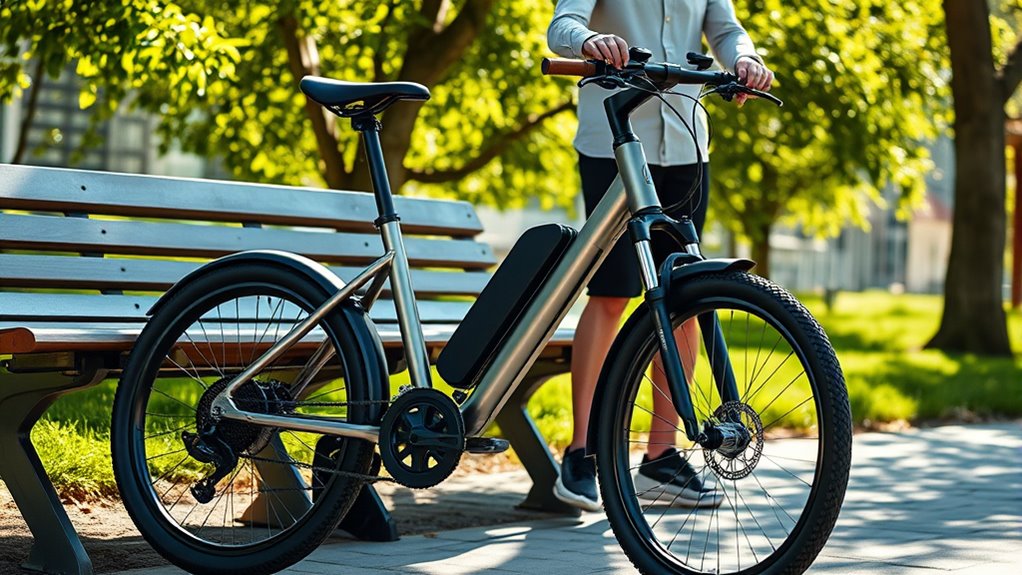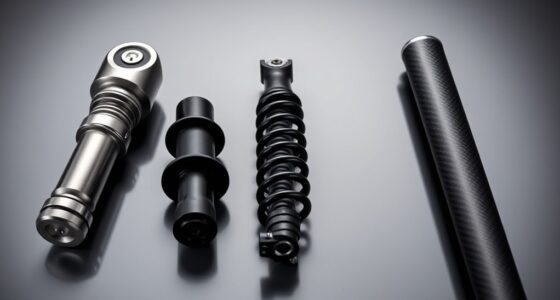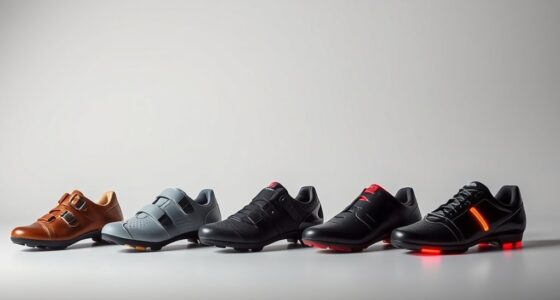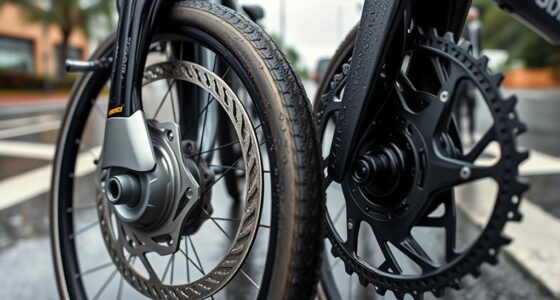Electric bikes use a battery-powered motor to assist your pedaling, making rides easier and faster. They feature components like batteries, motors, controllers, and different frame styles tailored to your needs. Depending on your terrain and riding style, you can choose from various assistance modes and batteries. Whether you’re commuting, exploring, or looking to reduce fatigue, an e-bike might be perfect for you. Explore further to learn how each part works and which type suits your lifestyle best.
Key Takeaways
- Electric bikes use a motor, battery, and controller to assist pedaling and enhance riding efficiency.
- Lithium-ion batteries provide lightweight, durable power sources, with capacity affecting range and charging time.
- Pedal assistance modes and adaptive technology tailor support based on terrain, speed, and rider input.
- Types of motors (hub or mid-drive) and frame styles influence performance, comfort, and suitability for different users.
- E-bikes are ideal for commuters, seniors, and recreational cyclists seeking easier, faster, and less tiring rides.
The Basic Components of an Electric Bike

Understanding the basic components of an electric bike is essential to appreciating how it works. Your bike’s battery is the backbone, providing the power needed for a smooth ride. Proper battery maintenance ensures longevity and peak performance, so keep it charged and avoid extreme temperatures. As the adoption of automation technologies increases across industries, similar advancements are also being integrated into electric bikes to improve their efficiency and functionality. The motor, usually installed near the pedals or wheel, converts electrical energy into motion. During motor installation, precise setup is vital to guarantee efficiency and safety. The controller manages power flow between the battery and motor, making your ride seamless. Additionally, the bike’s frame, brakes, and drivetrain work together to support your riding experience, often reflecting celebrity-inspired design trends that influence modern aesthetics.
How Electric Motors Power Your Ride
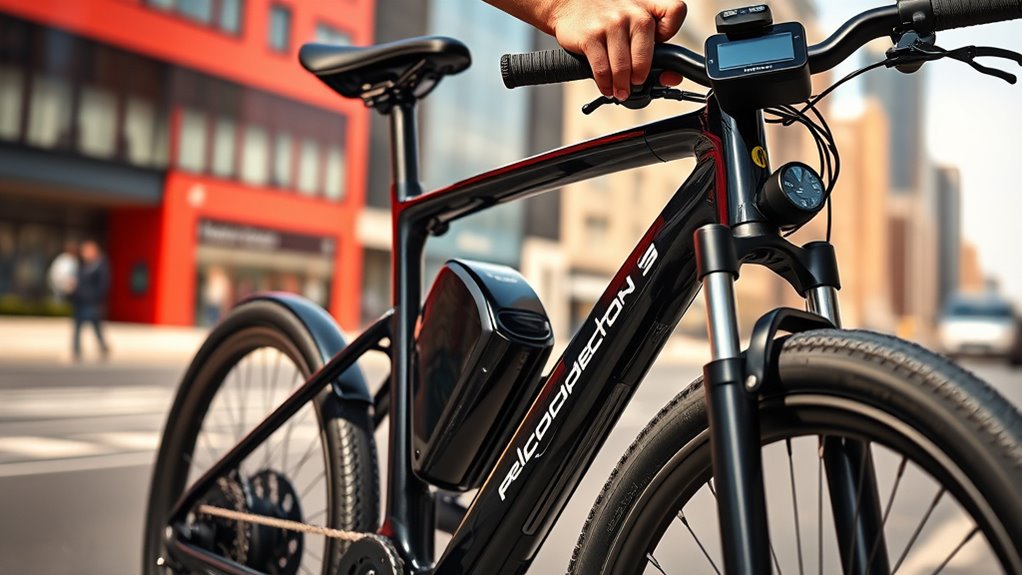
Electric motors are the heart of your e-bike’s power system, converting electrical energy from the battery into the mechanical force that propels you forward. Their motor efficiency determines how well this energy transfer occurs, impacting your ride’s range and performance. Thanks to electrical engineering, these motors are designed to optimize power output while minimizing energy loss. Kia Tuning techniques have also explored optimizing motor performance for various vehicle types, illustrating the importance of efficient motor design. Additionally, advancements in motor cooling methods can enhance durability and efficiency during extended use. Proper motor control systems contribute significantly to achieving smooth and precise acceleration, further improving overall performance. When you start pedaling, the motor’s coils generate a magnetic field that interacts with the rotor, creating torque. This seamless process allows for smooth acceleration and hill-climbing ability. Visualize: – A compact motor nestled near your crank or hub – Copper windings spinning inside a sealed casing – The magnetic attraction guiding your acceleration – The energy flow from battery to wheel, powering every turn. Modern electric motor efficiency techniques help extend battery life and improve overall e-bike performance, making your ride more reliable and enjoyable. This precise engineering ensures your ride is both powerful and efficient, highlighting how efficient motor design plays a crucial role in e-bike performance.
Types of E-Bike Batteries and Their Impact
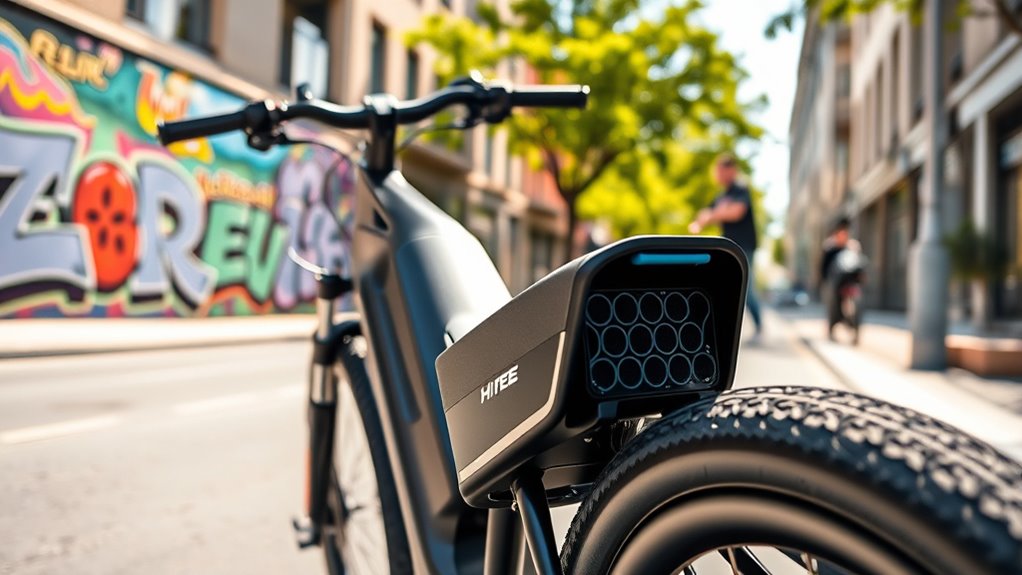
The type of battery your e-bike uses directly influences its range, power delivery, and overall performance. Lithium-ion batteries are the most common, offering a good balance of weight, capacity, and durability. They typically have a longer battery lifespan, meaning you’ll get more charge cycles before replacement is needed. Community support features from various apps can also help you optimize your battery usage through shared tips and experiences. Additionally, understanding the benefits of listening to classical music can be beneficial in reducing stress and enhancing focus during rides or maintenance routines.
Lithium-ion batteries are also known for their high suction power, which contributes to more effective and consistent performance during rides. Conversely, lead-acid batteries are heavier and have a shorter lifespan but are often cheaper upfront. The charging methods also vary; lithium-ion batteries support quick charging, allowing you to recharge faster, while others may take longer. Proper battery maintenance habits extend your battery’s lifespan and maintain excellent performance.
Understanding battery chemistry can help you better grasp how different types influence performance and lifespan. Choosing the right battery type depends on your riding needs and budget, but understanding these differences helps you make an informed decision for a reliable, efficient e-bike experience.
Different Pedal Assistance Modes
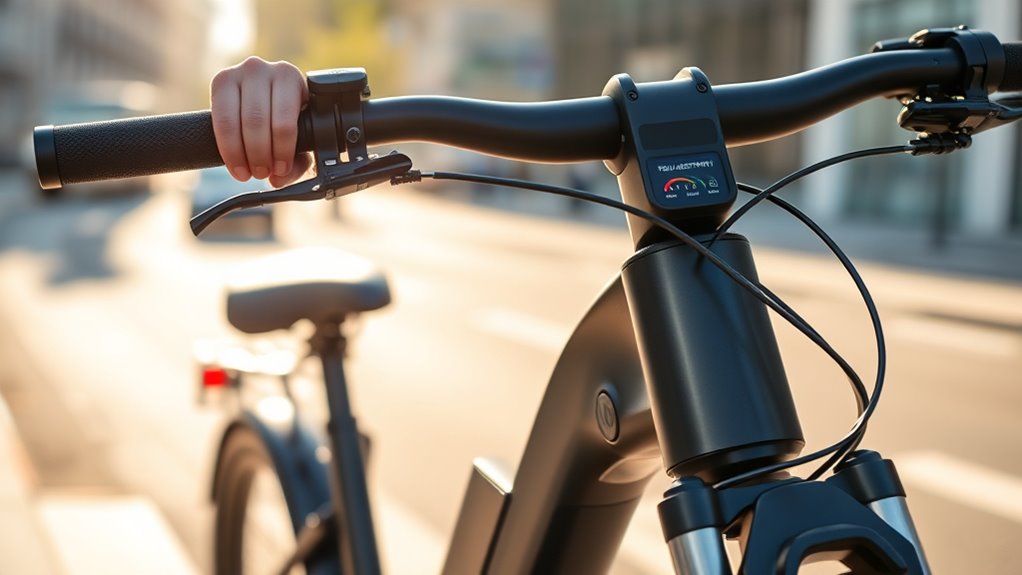
You’ll find electric bikes offer various pedal assistance modes to suit your riding style, from multiple power levels to adaptive features that adjust automatically. You can also switch to manual control if you prefer more direct input, giving you greater flexibility on the trail or city streets. Exploring these options helps you customize your ride for comfort and efficiency. Additionally, understanding the different assistance modes and their safety considerations ensures a more enjoyable and secure riding experience. As you explore these features, it’s helpful to know that some bikes incorporate battery capacity information to optimize performance and range during rides. Knowing how tuning techniques can modify your bike’s performance can help you achieve better handling and power output. Recognizing the spiritual insights from angel numbers can also inspire more mindful riding experiences, especially when riding through scenic or meaningful routes. Proper maintenance and care of your electric bike will ensure its longevity and optimal operation over time.
Power Levels Available
Have you ever wondered how different pedal assistance modes can enhance your riding experience? The power level settings in an e-bike allow you to choose from various assistance modes that match your needs. Whether you want a gentle boost or full-powered support, these modes give you control over your ride.
Imagine:
- Selecting a low assistance mode for a natural, pedal-only feel
- Switching to a higher setting when facing tough hills
- Adjusting assistance levels mid-ride for maximum energy use
- Using the highest power mode for quick acceleration and steep climbs
These assistance modes make riding adaptable, efficient, and more enjoyable, especially when you customize the power levels available to suit your terrain and riding style. Expertise in e-bike design ensures these modes are optimized for safety and performance. Additionally, regulation standards in modern e-bikes ensure that power assistance is safe, reliable, and tailored to user needs. Modern e-bike systems also incorporate power management features to extend battery life and improve overall efficiency. Employing appropriate assistance modes can also help prevent overexertion, making riding safer and more accessible for users of all fitness levels. Recognizing the importance of water efficiency in related technologies underscores the value of optimizing power use and minimizing unnecessary energy consumption in e-bike systems.
Adaptive Assistance Features
Adaptive assistance features allow your e-bike to automatically adjust pedal support based on your riding conditions and input. When you ride, the system analyzes factors like speed, cadence, and terrain to provide the most suitable level of help. Advanced tuning software can even be incorporated into maintenance routines for your bike, enhancing overall performance. This adaptive assistance offers a seamless experience, so you don’t have to switch modes manually. It enhances rider customization by tailoring support to your activity, whether you’re climbing hills or cruising flat roads. With these features, you conserve battery life by delivering power only when needed, while maintaining a natural riding feel. This smart assistance makes riding easier and more enjoyable, especially over varied terrain.
Manual Control Options
Manual control options allow riders to select from various pedal assistance modes, giving you direct control over how much help your e-bike provides. With a manual override, you can switch between modes to match your riding needs, whether you want a boost on steep hills or a more natural feel on flat terrain.
These user control features enable you to customize your experience easily. Imagine:
- Pushing a button or toggle for instant assistance level changes
- Cycling through modes with a simple handlebar switch
- Adjusting assistance for uphill climbs or downhill coasts
- Seamlessly switching between eco, standard, or high-power modes
These options make your ride more flexible and personalized, ensuring you’re always in control of your e-bike’s performance.
Comparing E-Bike Designs and Features
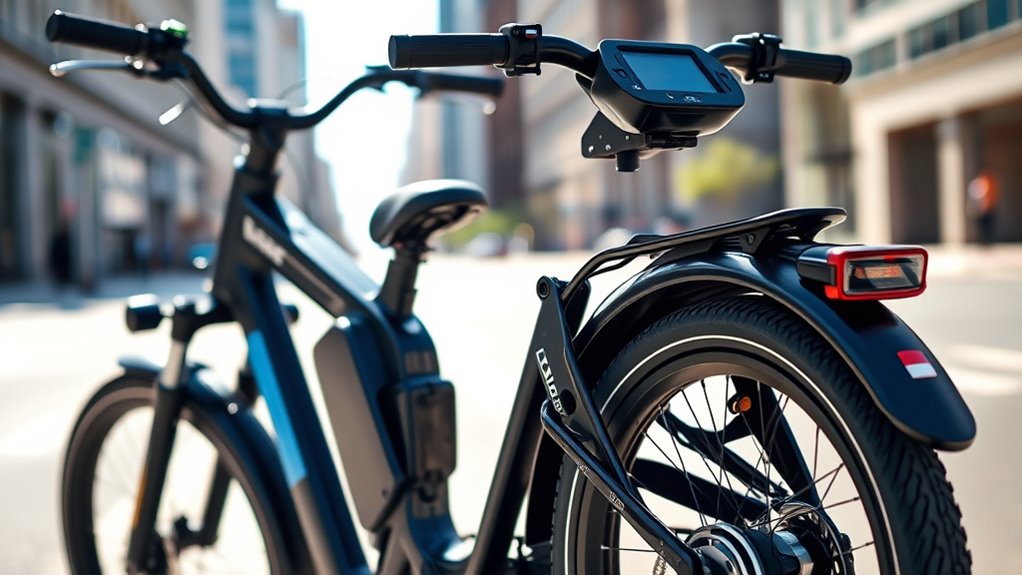
When comparing e-bike designs, you’ll notice differences in frame styles and materials that affect ride comfort and durability.
The motor types and power levels determine how much assistance you get and how fast you can go.
While battery capacity influences your range between charges.
Understanding these features helps you choose the e-bike that best fits your riding needs.
Frame Styles and Materials
Choosing the right frame style and material is crucial when selecting an e-bike, as these features directly influence ride quality, durability, and weight. The frame geometry determines how comfortable and stable your ride feels, whether you prefer a relaxed cruiser or a sporty setup.
Material durability varies with options like aluminum, carbon fiber, or steel, affecting how well your bike withstands daily use and rough terrains. Lightweight frames make pedaling easier, while sturdier ones offer added resilience.
Consider the following visuals when choosing your e-bike:
- Sleek, aerodynamic lines of carbon fiber frames
- Robust steel frames for heavy-duty rides
- Compact, foldable designs for portability
- Wide, knobby tires paired with sturdy frames for off-road adventures
Motor Types and Power
The type of motor and its power output substantially shape how your e-bike performs across different riding conditions. Motor configurations vary, including hub motors and mid-drive setups, each offering unique benefits.
Hub motors are typically simpler and provide smooth acceleration, while mid-drive motors deliver better weight distribution and efficiency for hilly terrain.
Power output options range from modest to high, affecting speed and torque. Higher wattage motors, such as 750W or more, give you stronger assistance for steep climbs and heavy loads, but may be subject to local regulations.
Lower power options, around 250W, are suitable for casual riding and legal classifications.
Choosing the right motor configuration and power output ensures your e-bike matches your riding style and terrain needs effectively.
Battery Capacity and Range
Ever wonder how far an e-bike can take you on a single charge? Your e-bike’s battery capacity determines its range, with larger batteries offering longer rides. Battery longevity depends on factors like usage and maintenance, while charging times can vary from a few hours to overnight.
When comparing designs, consider:
- The size of the battery pack, which influences range and weight
- Battery type, affecting longevity and efficiency
- Charging times, impacting how quickly you can get back on the road
- How well the battery handles frequent charging cycles
A bigger capacity means more miles per charge but can add weight, and longer-lasting batteries reduce replacement costs. Understanding these features helps you choose an e-bike suited for your riding needs and daily routine.
Who Can Benefit From Using an Electric Bike

Anyone looking to make their commute easier or explore new areas without overexerting themselves can benefit from an electric bike. Whether you’re a daily commuter or enjoy recreational cycling, an e-bike offers unmatched convenience. It helps you arrive faster, sweat less, and stay energized for the day. If mobility is a concern, or you want to extend your riding range, e-bikes provide the perfect solution. They’re ideal for urban dwellers, seniors, or anyone seeking a healthier lifestyle without the strain. Here’s a quick look at who benefits most:
| Who Benefits | Why |
|---|---|
| Commuters | Enhanced commuting convenience |
| Recreational cyclists | Longer, more relaxed rides |
| Seniors and those with mobility issues | Easier riding and reduced fatigue |
| Urban residents | Quick, eco-friendly transportation |
Tips for Choosing the Right E-Bike for You
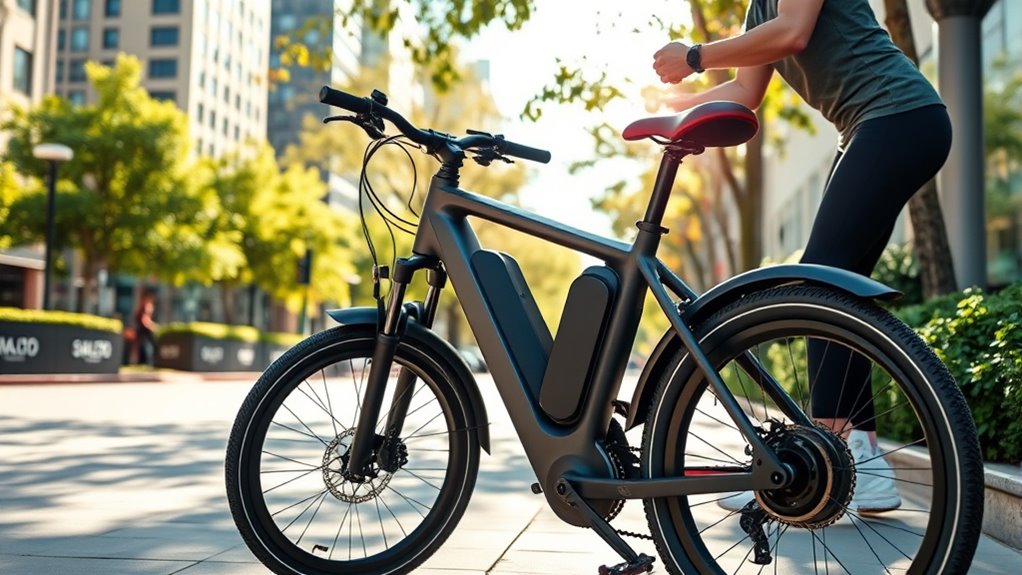
Choosing the right e-bike starts with understanding your riding needs and preferences. Think about where you’ll ride, how far, and the level of assistance you want.
To make an informed choice, consider these factors:
- The terrain you’ll tackle, like hills or flat roads
- Battery capacity, affecting how often you’ll need to recharge
- Features that enhance riding safety, such as lights and reflectors
- Ease of battery maintenance to keep your e-bike reliable and efficient
Selecting an e-bike suited to your needs ensures enjoyable rides and longevity. Proper battery maintenance is essential for peak performance, so check if the model offers easy access for upkeep.
Prioritizing safety features and understanding your riding style will help you find the perfect fit.
Frequently Asked Questions
How Long Do Electric Bike Batteries Typically Last Before Needing Replacement?
Your electric bike’s battery lifespan typically ranges from 500 to 1,000 full charge cycles. This means you might need a replacement around every 3 to 5 years with proper care.
The replacement timing depends on usage, maintenance, and charging habits.
To maximize battery life, avoid deep discharges and store it in a cool, dry place.
Regularly monitoring performance helps you know when it’s time for a replacement.
Are Electric Bikes Suitable for Off-Road or Rugged Terrain?
Imagine tackling a trail ride and feeling confident on rugged terrain—that’s where electric bikes shine. They’re designed for mountain biking and trail riding, with sturdy frames and powerful motors that handle dirt, rocks, and steep inclines effortlessly.
You’ll find them suitable for off-road adventures, giving you extra push and control. So, whether you’re exploring mountain trails or rough paths, electric bikes are built to keep up with your adventurous spirit.
What Maintenance Is Required to Keep an E-Bike Functioning Properly?
To keep your e-bike functioning properly, you need to perform regular maintenance. Focus on battery care by avoiding extreme temperatures and charging it properly.
Check your tire pressure frequently to ensure a smooth ride and prevent flats.
Keep the chain clean and lubricated, and inspect brakes regularly for responsiveness.
These simple steps help extend your e-bike’s lifespan and ensure safe, reliable rides every time.
Can Electric Bikes Be Folded or Stored Easily for Travel?
You might think electric bikes are bulky, but many models feature a folding design that makes storage and travel hassle-free.
Thanks to their portability features, you can easily fold your e-bike and fit it in a car trunk or carry it onto public transport. This convenience means you can take your e-bike anywhere, making it perfect for commuting, trips, or storage in tight spaces without sacrificing power or performance.
Are There Any Legal Restrictions or Age Limits for Riding E-Bikes?
Legal restrictions and age limits for riding e-bikes vary by location. You should check your local laws, as some areas require riders to be a certain age, often 14 or 16, and may mandate a license or helmet use.
Always stay informed about specific regulations in your area to guarantee you’re riding legally and safely.
Ignoring these restrictions could lead to fines or other penalties, so stay compliant.
Conclusion
Whether you’re cruising city streets or exploring trails, electric bikes open new adventures and make riding easier. As you discover the perfect fit, you might find yourself surprised how seamlessly e-bikes fit into your daily routine. Who would’ve thought that a little motor could boost your ride and brighten your day? So go ahead—embrace the electric revolution and see where it takes you. Sometimes, the best journeys are the ones you never expected to take!
